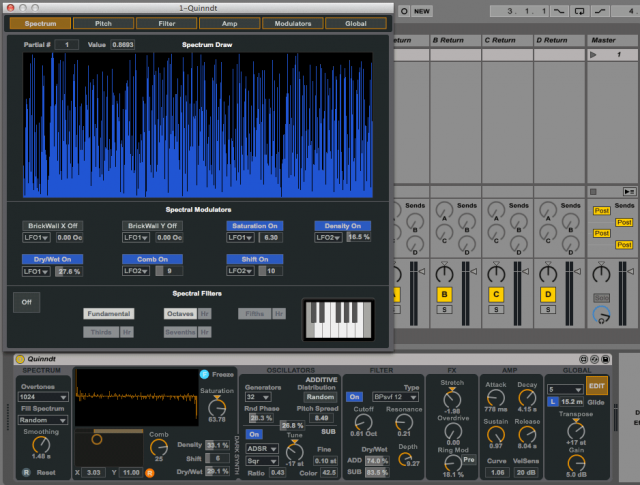
Amazing Noises has released Dark Synth, a new Max for Live synthesizer that marries the vast possibilities of additive synthesis with an intuitive interface.
With Dark Synth’s 2048 independently-controllable partials (sine wave oscillators) it’s possible to create everything from classic waveforms such as sawtooth and square, to complex custom waveshapes. But this is only the beginning – with direct access to each partial, you can take total control of your sound.
Here’s a video introduction to Dark Synth:
According to the developers, Dark Synth excels when it comes to generating strange and otherworldly sounds.
Here are the official audio demos for Dark Synth:
A unique feature of Dark Synth is the capability to create up to 128 detuned and phase-shifted copies of all 2048 partials. This vast ‘choir’ of oscillators creates a deep and natural chorus effect.
Dark Synth is available now for US $69.
If you’ve used Dark Synth, let us know what you think of it!

Live is really coming along, with major, positive options lately. The two deal-makers for this are the rise of CPUs that can handle the load and the breakthrough of grouping harmonics. The earlier Cameleon synth (now part of Alchemy), Razor and NI’s similar Prism synth bring the process up from the madness of adjusting hundreds to thousands of waves individually. Being able to massage groups of odd, even or random harmonics is the big key. It takes anal-retentive unsanity to twiddle it at the roots! Got a day to spend adjusting 1,024 separate harmonics within just one patch? Those groupings aren’t just some sales gimmick; they really get you close to what you’d aim for to begin with.
Those groupings aren’t just some sales gimmick; they really get you close to what you’d aim for to begin with.
Don’t just use it for dubcrap. Mixed in at a lower level underneath, additive strings can make a more muted or grainy ensemble patch stand out more. Same thing with putting a vocal formant under a ‘real’ choir. Its good for a range of bells, Clavs and metal sounds in general. I find it more useful as a layering element than a solo voice, because its like a stereo field expander minus the artifacts that can come with taking that route. Put a broad, rolling pad underneath a centered guitar part and listen to ’em both benefit from the contrast. It can stand out like a shout, but IMO, its big strength is its delicacy of tone. Its like a pinch of sugar or salt at just the right point. Additive isn’t the #1 sound-generating method everyone will reach for, but its also one of the Big Five. At $100 and less, its a good time to take it on and learn the basics.
This is not amazing, try using an old analogue number like a Sequential Circuits or Korg with a good reverb unit. I am astonished at just how much this is not amazing. People, musicians, please wise up – get yourselves some old analogue technology and use it with digital technology – wise up and build some electronics its not difficult, do it!
Sequential circuits and korg made an old, analogue additive synth? What was it called? I was under the impression that additive synthesis was a largely digital affair, due to the number of oscillators required. I’m tempted to suggest that it’s you who should “wise up”!
Korg only briefly dabbled in simple FM with the 707 and DS-8, a couple of decades back. Several companies made a point of carefully skirting Yamaha’s patents with designs that still yielded a few of their more interesting aspects. I can’t recall either company offering an additive synth. The early CPUs were too underpowered and costly. You sometimes get interesting little side versions of minor FM synthesis in a workstation or heftier performance synth, but its a very small subset of the bigger demands and rewards of true additive. That’s just a few sine waves stacked up against hundreds or thousands. I had a Kawai K5 and programming it through a stingy little LCD was maddening. It was a great synth trying hard to outstrip the limitations of that era. Well, those are resolved now. Using additive WELL is big-boy territory.
Additive synthesis has been around for 30 years.
http://www.soundonsound.com/sos/1997_articles/oct97/synthschool4.html
I think most of us know that It doenst make this synth seem less interresting and good.
It doenst make this synth seem less interresting and good.
You can modify the harmonic spectra in real-time, as seen near the end of the demo. Once you realize what a huge thing that really is, you’ll start feeling the tingle of Gear Lust for additive.
After having a play – this is a really good synth. The three inbuilt spectral LFO’s can create some lovely, weird sounds, and the interface is solid. Definitely worth the money. One gripe – it doesn’t automatically map (very many of) its functions to the Push controller. Pretty silly for a specifically Ableton synth.
Sound really nice! Mad to use this baby. Always looking for new and interesting sounds Bit of a price for a max instrument though in m opinion
Bit of a price for a max instrument though in m opinion
$69 Way overpriced.